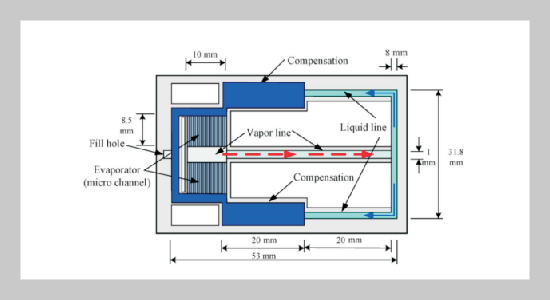Chin-Chun Hsu1, Shung-Wen Kang 1 and Tung-Fu Hou1
1Department of Mechanical and Electro-Mechanical Engineering, Tamkang University Tamsui, Taiwan 251, R.O.C.
Received:
January 3, 2005
Accepted:
March 15, 2005
Publication Date:
June 1, 2005
Download Citation:
||https://doi.org/10.6180/jase.2005.8.2.05
ABSTRACT
A 60 mm x 33 mm x 0.8 mm micro loop heat pipe (MLHP), consisting of an evaporator, vapor line, condenser and two liquid lines, was fabricated and characterized. The wicking structure consists of parallel V-grooves with a hydraulic diameter of 47 μm, 67 μm and 83 μm, and is formed by bulk silicon etching. The MLHP was realized by bonding a glass wafer onto a silicon substrate, so as to result in a transparent cover for two-phase flow visualization. Water and methanol were used as the working fluids. The test results showed that water demonstrates a wider heat load performance range (3.3 W~12.96 W) than methanol (1.2 W~5.85 W) for the MLHP with an evaporator area of 1 cm2 and condenser temperature of 17 ºC. The best thermal resistance of the MLHP was 0.106 ºC/W, 64 times higher than that without fluid filling. The smaller diameter grooves caused the higher liquid capillarity and enhanced transfer capacity. It was observed that the presence of non-condensable gas negatively affected the reliability of the MLHP and significantly reduced the performance.
Keywords:
Micro Loop Heat Pipes, Two Phase Flow, Non-condensable Gas, Thermal Resistance
REFERENCES
- [1] NASA Jet Propulsion Laboratory, www.jpl.nasa.gov.
- [2] Wolf, D. A., et al., “Loop Heat Pipe-Their Performance and Potential,” Dynatherm Corporation Inc, SAE Technical Paper No. 941575 (1994).
- [3] Kim, J. and Golliher, E., “Steady State Model of a Micro Loop Heat Pipe,” 18th IEEE SEMI-THERM Symposium, pp. 137 144 (2002).
- [4] Fox, R. W. and Mcdonald, A. T., Introduction to Fluid Mechanics Fifth_Edition, Wiley, NY, U.S.A. pp. 363 364 (1998).
- [5] Maidanik, Y. F., “Loop Heat Pipes Technology,” Solar Energy and Technology Conference, Taipei, Taiwan, pp. 50 56 (2000).















